These young scientists are passionate about tech and math
Student researchers from across the globe tackle everything from fish behavior and concrete to computer games

Figuring out how to carefully cure concrete — like that used in this ancient dome — can keep it from cracking. That was one of the projects tackled by some tech-savvy middle-school students from around the globe.
a_rancid_amoeba/ Flickr (CC BY-SA 2.0)
When it came to creating her own computer game, 13-year-old Kristyna Bednářová started from Scratch.
Scratch is a free computer programming language created at the Massachusetts Institute of Technology in Cambridge. Students around the world — including Kristyna, who lives in the Czech Republic — use the MIT language to create games, stories and animations. “I call it ‘School to Play,’” Kristyna says of her Scratch game. Its goal is to help students do better in school. “There are programs, for example, in math, English and physics,” she explains.
Such programming smarts makes Kristyna a standout student in science, technology, engineering and mathematics, or STEM. That’s why she was chosen to represent her country at the 2015 Broadcom MASTERS International. This program is a companion to the Broadcom MASTERS competition for U.S. middle-school students.
The 2015 international program brought together 24 student delegates — from 16 countries on six continents. They convened at the Intel International Science and Engineering Fair (ISEF). The Society for Science & the Public runs Broadcom MASTERS, Broadcom MASTERS International and Intel ISEF. It also publishes Science News for Students. This year’s Intel ISEF took place in Pittsburgh, Pa. The Broadcom MASTERS International delegates took part in some Intel ISEF activities. The young researchers also got to learn and share experiences as a group.
Like STEM, MASTERS is an acronym. It stands for “Math, Applied Science, Technology and Engineering Rising Stars.” The Broadcom Foundation sponsors both the U.S. competition and its companion international program. To be chosen as an international delegate, a student must have completed an outstanding STEM project. This year’s projects covered topics as varied as slime molds, running shoes and spacecraft.
Programmed to win
Lots of planning goes into making a computer game like Kristyna’s. She had to determine the broad challenges that players would face in the game. Those include determining the object of the game. For instance, Kristyna had to figure out what a player must do to achieve that goal.
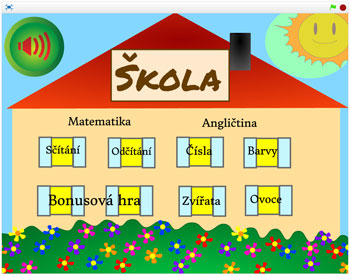
She also had to design how a player progresses from the start of the game to its finish. And at each stage, Kristyna had to decide what would appear on the computer screen, along with what choices players could make, and when. And, of course, each choice must have its consequences.
Detailed planning even went into parts of the game that players never see. Kristyna, or any programmer, must tell the computer exactly what to do at every step. So the program writer must follow the rules of a particular programming language. And the programming behind the game must always reflect clear and logical thinking. Indeed, if any step is left out, the game won’t work.
Kristyna wasn’t the only Broadcom MASTERS International delegate who mastered computer programming. “My project is a program that teaches students software coding,” says 12-year-old Deun Sol Lee of South Korea. His program helps young people learn to write their own programs.
Deun Sol got the idea after learning that some schools now teach software coding. “I think that would be very good to know,” he says. Deun Sol wrote his program using a computer programming language called C++.
Widgets and gadgets
Adam Barry, 13, wants his computer skills to help businesses get more work done. So the teen from Ireland designed a project that he says offers “a way of getting employees to work faster in call centers.” Typically, these workers respond to telephone calls from people asking (or complaining) about a company’s products or services.
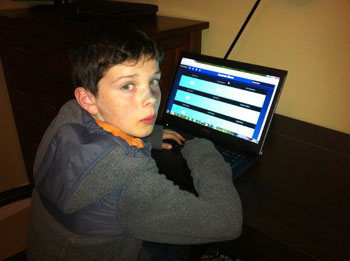
In a car, a dashboard gives a driver the information needed to control the vehicle. Some computers also have a “dashboard” that lets a user decide where to go or what to do, whether with a computer program or on a website. Any computer dashboard usually will include several widgets. Those are tools that provide users with information so that they can choose specific actions. Buttons and pull-down menus are examples.
The dashboard for Adam’s project can connect to a phone system. Now, he explains, “whenever a new call comes in, the widget that says ‘new calls’ might change and go up by one.” Workers could see when calls start to pile up, unanswered. The hope is that such information might get workers to wrap up each call more quickly.
Like Kristyna and Deun Sol, Adam had to plan out every part of his program. That included computer instructions that workers using the dashboard would never see. People at real call centers might be using Adam’s project soon. He designed it as a prototype, or early model, for one of his dad’s business projects.
Science fair projects for some other Broadcom MASTERS International participants involved different kinds of important computer skills. For example, 14-year-old Kianah Blakely-White, of Monroeville, Pa., used computer software to design a foam insert for running shoes. Kianah runs track. She says that her shoe inserts might help runners boost their sprinting speeds. A sprint is a race run over a short distance. For her project, Kianah needed to understand factors that would help a runner go faster. She also had to know how to use the computer software in order to design the insert.
For his project, 12-year-old Ori Shaham of Israel worked on a device to make it easier for people to put eye drops into their own eyes. The result of Ori’s work is a special eyedropper bottle. It includes a spot to attach a curved mirror. The mirror lets a user see just where the drops are going. To make the gadget, Ori used a 3-D printer. A computer tells the printing machine where to place, or “print,” drops of plastic, metal or another material. Ori needed to not only engineer the bottle but also use computer skills to get the 3-D printer to make it.
Math masters
Mathematics took center stage in projects by other Broadcom MASTERS International delegates. Petrus Daniel Steyn of South Africa loves math. The 14-year-old also enjoys playing the violin. Those two passions led the teen to ask: Is there a mathematical relationship between musical notes and their frequencies?
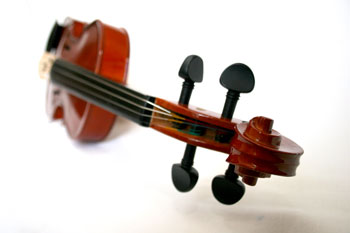
“There is a mathematical pattern to music,” Daniel says. He measured the frequency of different notes. On the violin, he saw a pattern. Notes played on longer strings had lower frequencies than notes played on shorter strings. In other words, Daniel saw an inverse correlation. As their string length increased, the frequency of the notes decreased.
Daniel was also curious about the overtones for different notes. In simplest terms, overtones make up part of a note’s full sound. They are higher pitches that a listener also hears as part of that main note. Daniel measured the frequency of notes and their overtones for both the violin and the flute. For each instrument, he then came up with equations to find the overtones for any note.
Thirteen-year-old Tianle “James” Yang of China also used math in his project. He wants his work to have a concrete benefit — literally. James says he wants to help find a way to make “solid concrete that will not crack.”
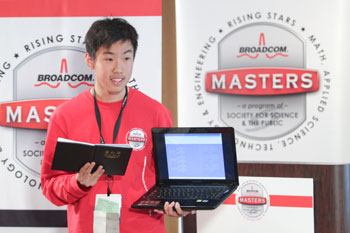
Here is the problem. To make concrete, builders mix cement, water and other materials, such as gravel, crushed rock or sand. The process starts a chemical reaction. Eventually, the concrete hardens. But first something else occurs. “The chemical reaction causes things to heat up,” James explains. “The temperatures rise inside the concrete.” That process can last up to 21 days, he notes. During that time, the heat makes the concrete expand. Later, as it cools the concrete will contract. But if the concrete expands or shrinks too much or too quickly, it will crack. Then concrete slabs or bricks might not fit together well.
James built on previous work to look for ways to improve computer models of what the chemical reaction does to concrete. A computer model uses data and math to simulate, or mimic, something from the real world. In this case, different models dealt with the heating in concrete as it hardens, or cures.
Statistics is the practice or science of collecting and analyzing numerical data in large quantities and interpreting their meaning. James combined statistics from different models. Further work will be needed to test his improvements. Ultimately, James hopes his work will lead to safer buildings.
Strength in numbers
Other projects also called for the use of statistics. Henry Kuo, 14, of Taiwan studied how being part of a group might help mosquito fish. These freshwater fish populate many ponds where they feast on mosquito larvae.
Henry did experiments with live mosquito fish using different conditions, such as group size. He also repeated experiments some 7 to 10 times, depending on how large a group was. Group sizes ranged from 1 to 23 fish. Using statistics, Henry then compared the results. It pointed to trends, such as how well the fish did in finding food.
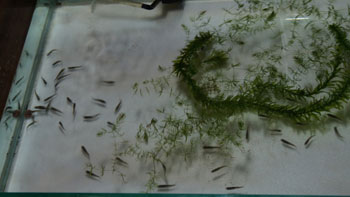
Being in a group “actually increases the survival rates of the fish,” Henry found. “They can find food quicker and they can avoid predators better.” Don’t worry — a glass barrier kept any live predators from eating Henry’s fish in these tests. He also usedsimulated predators — computer images on a tablet computer and a handmade shiny red fish with big eyes.
Groups of 6 to 12 fish performed the best in Henry’s experiments. “When group size is too small, there may not be effective leaders,” he posits. “And when group sizes reach more than 14, the group tends to split into two or more smaller groups.”
Henry only had space and time to raise a limited number of mosquito fish. He wondered what might happen in larger groups, such as 100 fish. To find out, he used a computer modeling technique called the Monte Carlo method. It picks numbers at random over and over again from a database. Then it predicts what would happen if someone ran an experiment hundreds or thousands of times. The result is an estimate of what might happen in the real world.
What else might middle-school students around the world develop or discover with their science fair projects? Stay tuned for next year’s Broadcom MASTERS International to find out.
Power Words
(for more about Power Words, click here)
acronym A word made by combining some of the starting letter or groups of letters from a number of words. For instance, STEM is an acronym for Science, Technology, Engineering and Math. Radar is an acronym for RAdio Detection And Ranging. Even laser is an acronym for Light Amplification by Stimulated Emission of Radiation.
Broadcom MASTERS Created and run by the Society for Science & the Public, Broadcom MASTERS (Math, Applied Science, Technology and Engineering Rising Stars) is the premier middle school science and engineering fair competition. Broadcom MASTERS International gives select middle school students from around the world a unique opportunity to attend the Intel International Science & Engineering Fair.
chemical reaction A process that involves the rearrangement of the molecules or structure of a substance, as opposed to a change in physical form (as from a solid to a gas).
code (in computing) To use special language to write or revise a program that makes a computer do something.
coding A slang term for developing computer programming — or software — that performs a particular, desired computational task.
computer model A program that runs on a computer that creates a model, or simulation, of a real-world feature, phenomenon or event.
computer program A set of instructions that a computer uses to perform some analysis or computation. The writing of these instructions is known as programming.
concrete To be solid and real. (in construction) A simple, two-part building material. One part is made of sand or ground-up bits of rock. The other is made of cement, which hardens and helps bind the grains of material together.
correlation A mutual relationship or connection between two variables. When there is a positivecorrelation, an increase in one variable is associated with an increase in the other. (For instance, scientists might correlate an increase in time spent watching TV with an increase in risk of obesity.) Where there is an inverse correlation, an increase in one value is associated with a decrease in the other. (Scientists might correlate an increase in TV watching with a decrease in time spent exercising each week.) A correlation between two variables does not necessarily mean one is causing the other.
database An organized collection of information.
engineering The field of research that uses math and science to solve practical problems.
equation In mathematics, the statement that two quantities are equal. In geometry, equations are often used to determine the shape of a curve or surface.
frequency The number of times a specified periodic phenomenon occurs within a specified time interval. (In physics) The number of wavelengths that occurs over a particular interval of time.
inverse Something that is the opposite or reverse of another thing, or that moves in the opposite direction to something.
larva (plural: larvae) An immature life stage of an insect, which often has a distinctly different form as an adult. (Sometimes used to describe such a stage in the development of fish, frogs and other animals too.)
Monte Carlo method A mathematical technique that repeatedly samples elements from a set of numbers. By picking numbers at random over and over again from a database describing a particular situation or type of event, the Monte Carlo method can predict something that is currently unknown (such as the shape of a pictured object, for instance, or the risk of cancer spreading to other areas of the body).
pitch (in acoustics) The word musicians use for sound frequency. It describes how high or low a sound is, which will be determined by the vibrations that created that sound.
predator (adjective: predatory) A creature that preys on other animals for most or all of its food.
programming (in computing) To use a computer language to write or revise a set of instructions that makes a computer do something. The set of instructions that does this is known as a computer program.
prototype A first or early model of some device, system or product that still needs to be perfected.
simulate To deceive in some way by imitating the form or function of something. A simulated dietary fat, for instance, may deceive the mouth that it has tasted a real fat because it has the same feel on the tongue — without having any calories. A simulated sense of touch may fool the brain into thinking a finger has touched something even though a hand may no longer exists and has been replaced by a synthetic limb. (in computing) To try and imitate the conditions, functions or appearance of something. Computer programs that do this are referred to as simulations.
slime mold A simple organism that consists of a single cell of creeping, jellylike protoplasm containing nuclei. It is not a mold, despite its name; it isn’t even closely related to fungi.
Society for Science & the Public (or SSP) A nonprofit organization created in 1921 and based in Washington, D.C. Since its founding, SSP has been not only promoting public engagement in scientific research but also the public understanding of science. It created and continues to run three renowned science competitions, including the Intel International Science and Engineering Fair (initially launched in 1950). SSP also publishes award-winning journalism in Science News (launched in 1922) andScience News for Students (created in 2003). Those magazines also host a series of blogs (includingEureka! Lab).
software The mathematical instructions that direct a computer’s hardware, including its processor, to perform certain operations.
statistics The practice or science of collecting and analyzing numerical data in large quantities and interpreting their meaning. Much of this work involves reducing errors that might be attributable to random variation. A professional who works in this field is called a statistician.
STEM An acronym (abbreviation made using the first letters of a term) for science, technology, engineering and math.
tablets (in computing) A small, hand-held computer that can connect to the Internet and that users can control using a touch screen. An Apple iPad, Samsung Galaxy and Amazon Kindle Fire are all examples of tablets.
technology The application of scientific knowledge for practical purposes, especially in industry — or the devices, processes and systems that result from those efforts.
three-dimensional (3-D) printer A machine that takes instructions from a computer program on where to lay down successive layers of some raw material to create a three-dimensional object.
three-dimensional (3-D) printing The creation of a three-dimensional object with a machine that follows instructions from a computer program. The computer tells the printer where to lay down successive layers of some raw material, which can be plastic, metals, food or even living cells. 3-D printing is also called additive manufacturing.
widget In computer science, a tool built into a program or website that lets a user take action in response to information provided on screen.







